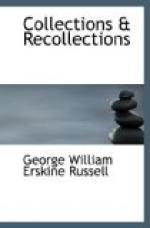These more distinguished portraits, of cabinet dimensions, were scattered up and down among the miscellaneous herd of cartes de visits. The art of Messrs. Hills and Saunders was denoted by the pretentious character of the chairs introduced—the ecclesiastical Glastonbury for masters, and velvet backs studded with gilt nails for boys. The productions of the rival photographer were distinguished by a pillar of variegated marble, or possibly scagliola, on which the person portrayed leaned, bent, or propped himself in every phase of graceful discomfort. The athletes and members of the School Eleven, dressed in appropriate flannel, were depicted as a rale with their arms crossed over the backs of chairs, and brought very much into focus so as to display the muscular development in high relief. The more studious portion of the community, “with leaden eye that loved the ground,” scanned small photograph-books with absorbing interest; while a group of editors, of whom I was one, were gathered round a writing-table, with pens, ink, and paper, the finger pressed on the forehead, and on the floor proofs of the journal which we edited—was it the Tyro or the Triumvirate?
Among the athletes I instantly recognize Biceps Max., captain of the Cricket Eleven, and practically autocrat of my house—“Charity’s” the house was called, in allusion to a prominent feature of my tutor’s character. Well, at Charity’s we did not think much of intellectual distinction in those days, and little recked that Biceps was “unworthy to be classed” in the terminal examination. We were much more concerned with the fact that he made the highest score at Lord’s; that we at Charity’s were absolutely under his thumb, in the most literal acceptation of that phrase; that he beat us into mummies if we evaded cricket-fagging; and that if we burnt his toast he chastised us with a tea-tray. Where is Biceps now, and what? If he took Orders, I am sure he must be a muscular Christian of the most aggressive type. If he is an Old Bailey barrister, I pity the timid witness whom he cross-examines. Why do I never meet him at the club or in society? It would be a refreshing novelty to sit at dinner opposite a man who corrected your juvenile shortcomings with a tea-tray. Would he attempt it again if I contradicted him in conversation, or confuted him in argument, or capped his best story with a better?
Next comes Longbow—Old Longbow, as we called him; I suppose as a term of endearment, for there was no Young Longbow. He was an Irishman, and the established wit, buffoon, and jester of the school. Innumerable stories are still told of his youthful escapades, of his audacity and skill in cribbing, of his dexterity in getting out of scrapes, of his repartees to masters and persons in authority. He it was who took up the same exercise in algebra to Mr. Rhomboid all the time he was in the Sixth Form, and obtained maiks, ostensibly for a French exercise,




